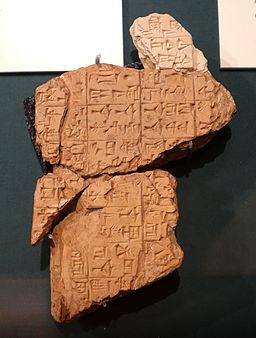Instructions of Shuruppak

The Instructions of
The text consists of admonitory sayings of Šuruppak addressed to his son and eventual
The Abu Salabikh tablet, dated to the mid-third millennium BCE,[7] is the oldest extant copy, and the numerous surviving copies attest to its continued popularity within the Sumerian/Akkadian literary canons.[8]
Counsels in the three conjoined lists are pithy, occupying one to three lines of cuneiform. Some counsel is purely practical: You should not locate a field on a road; .... You should not make a well in your field: people will cause damage on it for you. (lines 15–18). Moral precepts are followed by the negative practical results of transgression: You should not play around with a married young woman: the slander could be serious. (lines 32–34). Community opinion and the possibility of slander (line 35) play a major role, whether the valued opinion of "the courtyard" (line 62) or the less valued opinion of the marketplace, where insults and stupid speaking receive the attention of the land. (line 142).
The Instructions contain precepts that reflect those later included in the Ten Commandments,[9] and other sayings that are reflected in the biblical Book of Proverbs.
See also
References
- ^ Hesiod (2006). Most, Glenn W. (ed.). Theogony, Works and Days, Testimonia. Loeb Classical Library. Harvard University Press. p. xlvi.
- ^ "The most significant piece of wisdom literature in Sumerian", asserts Paul-Alain Beaulieu, in Richard J. Clifford, ed., Wisdom Literature in Mesopotamia and Israel 2007:4.
- ^ Instructions of Shuruppak: from W. G. Lambert (1996) Babylonian Wisdom Literature. (Eisenbrauns, Winona Lake, Indiana) Includes on-line English translation of the text.
- ISBN 9780241289907.
- .
- ISBN 9780931464942. Retrieved 2015-06-03.
- ISBN 0-226-62202-9.
- ^ Two fragmentary Akkadian versions survive, from the 15th century BCE and from the end of the second millennium BCE: "Its great antiquity and popularity is evidenced by the large number of manuscripts of it that have survived" (Beaulieu in Clifford 2007:4).
- ^ The Schoyen Collection website notes, from a Neo-Sumerian tablet of ca. 1900–1700 BCE: line 50: Do not curse with powerful means (3rd Commandment); line 28: Do not kill (6th Commandment); lines 33–34: Do not laugh with or sit alone in a chamber with a girl that is married (7th Commandment); lines 28–31: Do not steal or commit robbery (8th Commandment); and line 36: Do not spit out lies (9th Commandment).
Further reading
- Bendt Alster The Instructions of Shuruppak. A Sumerian Proverb Collection, (Copenhagen: Akademisk Forlag) 1974.
- Alster, Bendt, "Shuruppak’s Instructions — Additional lines identified in the Early Dynastic Version", Zeitschrift für Assyriologie und Vorderasiatische Archäologie, vol. 80, no. 1-2, pp. 15-19, 1990
